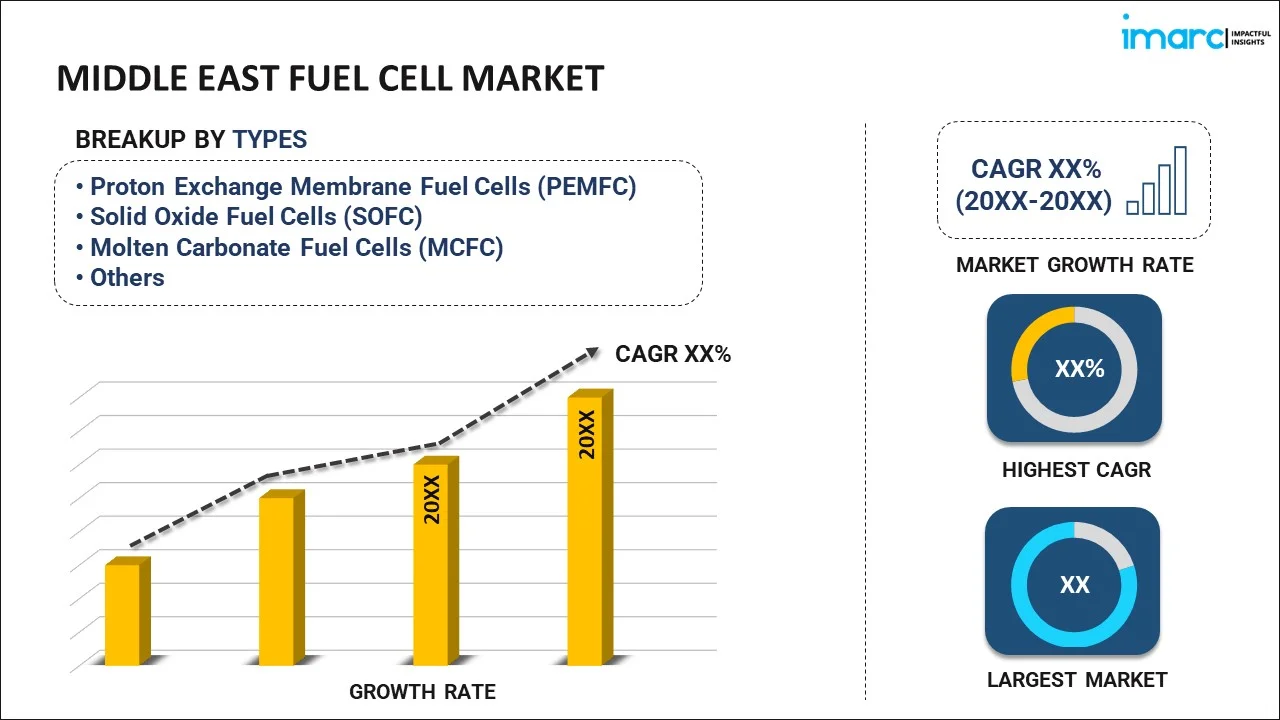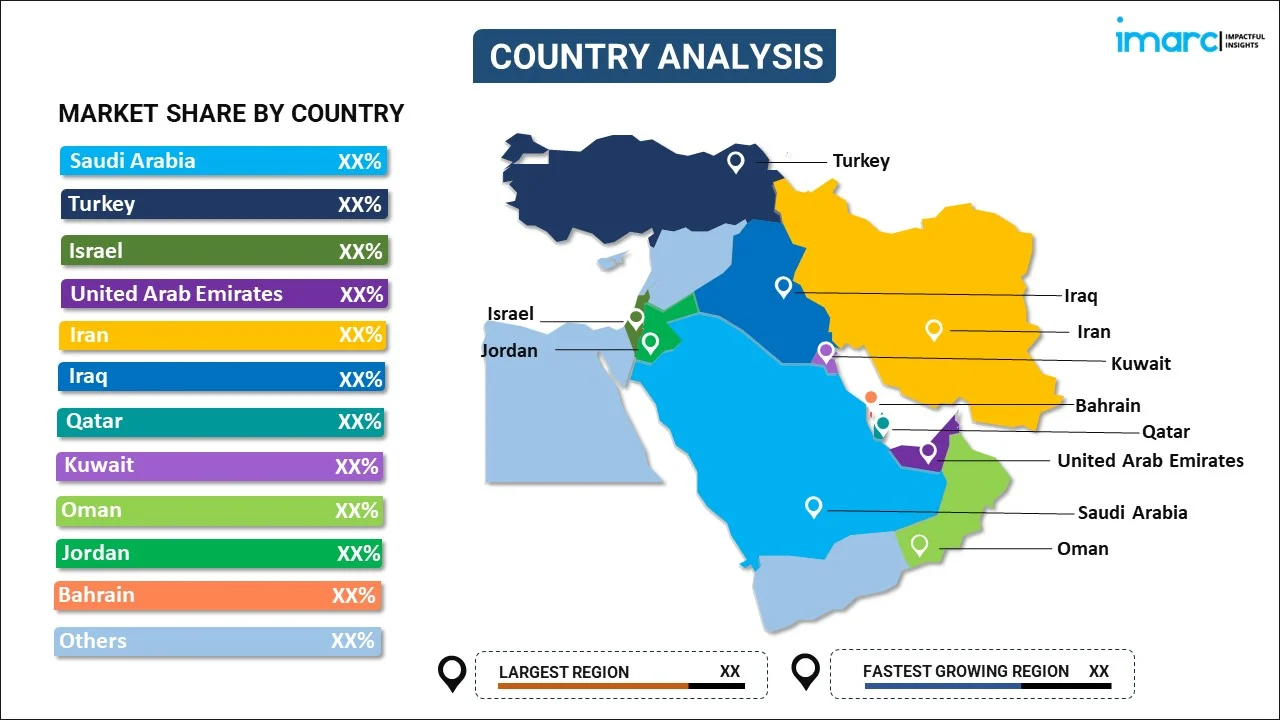
Middle East Fuel Cell Market Report by Type (Proton Exchange Membrane Fuel Cells (PEMFC), Solid Oxide Fuel Cells (SOFC), Molten Carbonate Fuel Cells (MCFC), Direct Methanol Fuel Cells (DMFC), Phosphoric Acid Fuel Cells (PAFC), and Others), Application (Stationary, Transportation, Portable), and Country 2026-2034
Market Overview:
Middle East fuel cell market size reached USD 328.3 Million in 2025. Looking forward, IMARC Group expects the market to reach USD 897.6 Million by 2034, exhibiting a growth rate (CAGR) of 11.82% during 2026-2034. The increasing emphasis on sustainability and environmental concerns, expanding applications in stationary power and backup applications, and the rising awareness among the masses and businesses about the energy efficiency of fuel cells represent some of the key factors driving the market.
|
Report Attribute
|
Key Statistics
|
|---|---|
|
Base Year
|
2025
|
|
Forecast Years
|
2026-2034
|
|
Historical Years
|
2020-2025
|
|
Market Size in 2025
|
USD 328.3 Million |
|
Market Forecast in 2034
|
USD 897.6 Million |
| Market Growth Rate 2026-2034 | 11.82% |
Access the full market insights report Request Sample
A fuel cell is an electrochemical device that converts chemical energy from a fuel through a chemical reaction with oxygen or another oxidizing agent. It is clean and environment friendly, as it emits only water vapor and heat as byproducts. It is versatile and can be used in various sizes, ranging from small portable devices to large-scale power plants. It has low noise levels and experiences less mechanical wear and tear due to fewer moving parts. It contributes to a reduction in greenhouse gas emissions, making it a sustainable energy option. It provides a more efficient way to convert fuel into electricity compared to many other technologies. It offers reliable and continuous power generation, making it suitable for several applications. Its flexibility in size and capacity makes it adaptable for various purposes. It is widely used for providing backup power for homes, businesses, and critical infrastructure. Besides this, it is also utilized in military vehicles and equipment for silent operation and reduced emissions. Moreover, it is employed by spacecraft and space stations for power generation.
Middle East Fuel Cell Market Trends:
The increasing emphasis on sustainability and environmental concerns represents one of the primary factors catalyzing the demand for fuel cells in the Middle East. Additionally, the rising awareness among the masses and businesses about the energy efficiency of fuel cells is driving the market. Apart from this, continuous advancements in hydrogen production methods, including green hydrogen production through renewable energy sources and electrolysis, are making hydrogen more accessible and cost-effective. Furthermore, governing authorities in the region are implementing policies and offering tax incentives and subsidies to encourage the development and deployment of fuel cell technologies. These incentives reduce the financial barriers for businesses and individuals looking to invest in fuel cell systems, stimulating the market growth. Moreover, these agencies are increasingly investing in research and development (R&D) activities to accelerate technological advancements in fuel cell technology. In line with this, the expanding applications of fuel cells in stationary power and backup applications are influencing the market positively. They provide a reliable source of electricity during grid outages and serve as backup power systems for hospitals, data centers, and telecommunications facilities. In addition, the integration of renewable energy sources, such as wind and solar, into the electricity grid is driving the adoption of fuel cells in the Middle East. Fuel cells can efficiently convert excess electricity generated from renewables into hydrogen through electrolysis. Moreover, advancements in materials, manufacturing processes, and system design are making fuel cells more efficient, durable, and affordable, attracting a wider consumer base. Along with this, several automakers are increasingly investing in fuel cell electric vehicles (FCEVs) as an alternative to traditional internal combustion engine vehicles and battery electric vehicles (BEVs).
Middle East Fuel Cell Market Segmentation:
IMARC Group provides an analysis of the key trends in each segment of the market, along with forecasts at the regional and country levels for 2026-2034. Our report has categorized the market based on type and application.
Type Insights:

To get detailed segment analysis of this market Request Sample
- Proton Exchange Membrane Fuel Cells (PEMFC)
- Solid Oxide Fuel Cells (SOFC)
- Molten Carbonate Fuel Cells (MCFC)
- Direct Methanol Fuel Cells (DMFC)
- Phosphoric Acid Fuel Cells (PAFC)
- Others
The report has provided a detailed breakup and analysis of the market based on the type. This includes proton exchange membrane fuel cells (PEMFC), solid oxide fuel cells (SOFC), molten carbonate fuel cells (MCFC), direct methanol fuel cells (DMFC), phosphoric acid fuel cells (PAFC), and others.
Application Insights:
- Stationary
- Transportation
- Portable
A detailed breakup and analysis of the market based on the application have also been provided in the report. This includes stationary, transportation, and portable.
Country Insights:

To get detailed regional analysis of this market Request Sample
- Saudi Arabia
- Turkey
- Israel
- United Arab Emirates
- Iran
- Iraq
- Qatar
- Kuwait
- Oman
- Jordan
- Bahrain
- Others
The report has also provided a comprehensive analysis of all the major regional markets, which include Saudi Arabia, Turkey, Israel, United Arab Emirates, Iran, Iraq, Qatar, Kuwait, Oman, Jordan, Bahrain, and Others.
Competitive Landscape:
The market research report has also provided a comprehensive analysis of the competitive landscape in the market. Competitive analysis such as market structure, key player positioning, top winning strategies, competitive dashboard, and company evaluation quadrant has been covered in the report. Also, detailed profiles of all major companies have been provided.
Middle East Fuel Cell Market Report Coverage:
| Report Features | Details |
|---|---|
| Base Year of the Analysis | 2025 |
| Historical Period | 2020-2025 |
| Forecast Period | 2026-2034 |
| Units | Million USD |
| Scope of the Report | Exploration of Historical and Forecast Trends, Industry Catalysts and Challenges, Segment-Wise Historical and Predictive Market Assessment:
|
| Types Covered | Proton Exchange Membrane Fuel Cells (PEMFC), Solid Oxide Fuel Cells (SOFC), Molten Carbonate Fuel Cells (MCFC), Direct Methanol Fuel Cells (DMFC), Phosphoric Acid Fuel Cells (PAFC), Others |
| Applications Covered | Stationary, Transportation, Portable |
| Countries Covered | Saudi Arabia, Turkey, Israel, United Arab Emirates, Iran, Iraq, Qatar, Kuwait, Oman, Jordan, Bahrain, Others |
| Customization Scope | 10% Free Customization |
| Post-Sale Analyst Support | 10-12 Weeks |
| Delivery Format | PDF and Excel through Email (We can also provide the editable version of the report in PPT/Word format on special request) |
Key Questions Answered in This Report:
- How has the Middle East fuel cell market performed so far and how will it perform in the coming years?
- What has been the impact of COVID-19 on the Middle East fuel cell market?
- What is the breakup of the Middle East fuel cell market on the basis of type?
- What is the breakup of the Middle East fuel cell market on the basis of application?
- What are the various stages in the value chain of the Middle East fuel cell market?
- What are the key driving factors and challenges in Middle East fuel cell?
- What is the structure of the Middle East fuel cell market and who are the key players?
- What is the degree of competition in the Middle East fuel cell market?
Key Benefits for Stakeholders:
- IMARC’s industry report offers a comprehensive quantitative analysis of various market segments, historical and current market trends, market forecasts, and dynamics of the Middle East fuel cell market from 2020-2034.
- The research report provides the latest information on the market drivers, challenges, and opportunities in the Middle East fuel cell market.
- Porter's five forces analysis assist stakeholders in assessing the impact of new entrants, competitive rivalry, supplier power, buyer power, and the threat of substitution. It helps stakeholders to analyze the level of competition within the Middle East fuel cell industry and its attractiveness.
- A competitive landscape allows stakeholders to understand their competitive environment and provides an insight into the current positions of key players in the market.
Need more help?
- Speak to our experienced analysts for insights on the current market scenarios.
- Include additional segments and countries to customize the report as per your requirement.
- Gain an unparalleled competitive advantage in your domain by understanding how to utilize the report and positively impacting your operations and revenue.
- For further assistance, please connect with our analysts.
 Request Customization
Request Customization
 Speak to an Analyst
Speak to an Analyst
 Request Brochure
Request Brochure
 Inquire Before Buying
Inquire Before Buying




.webp)




.webp)












